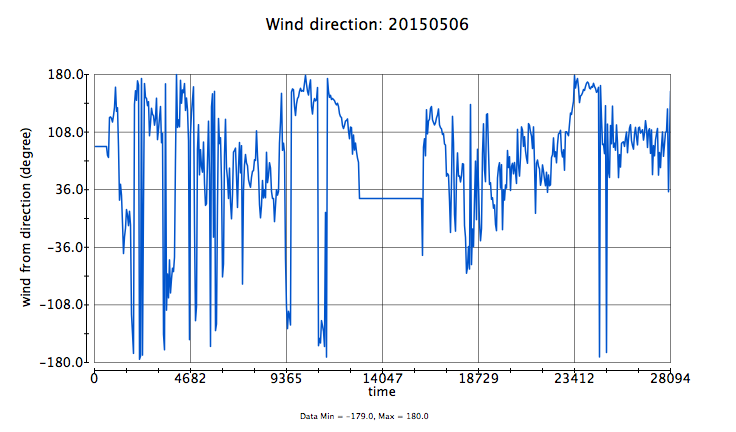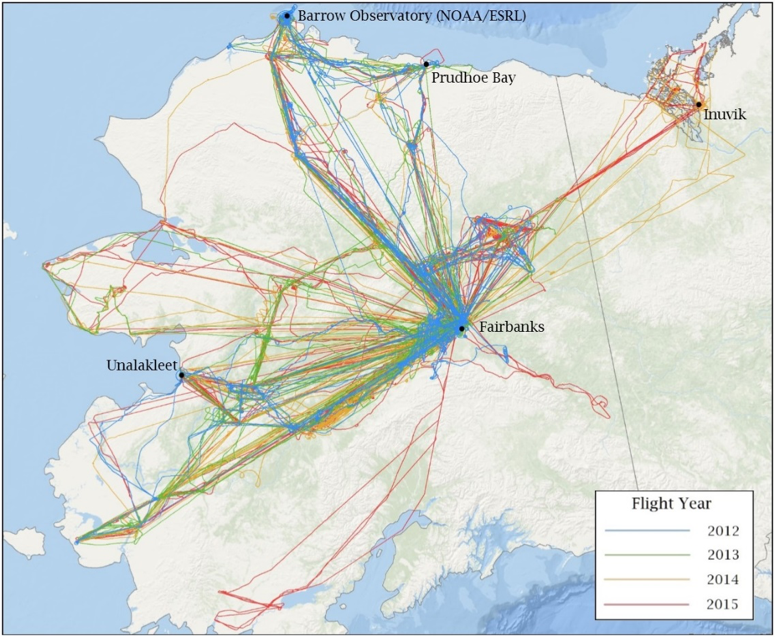Documentation Revision Date: 2017-02-22
Data Set Version: V1
Summary
These measurements are one part of an innovative multi-instrument remote sensing payload flown for the CARVE investigation.
There are 60 data files in netCDF (*.nc) format; each file corresponds to one CARVE campaign flight in year 2015, but not all flights are represented.

Figure 1: Wind direction recorded outside the C-23 Sherpa aircraft during a CARVE flight on May 6, 2015.
Citation
CARVE Science Team . 2017. CARVE: L1 Daily Flight Path and Winds Data, Alaska, 2015. ORNL DAAC, Oak Ridge, Tennessee, USA. http://dx.doi.org/10.3334/ORNLDAAC/1427
Table of Contents
- Data Set Overview
- Data Characteristics
- Application and Derivation
- Quality Assessment
- Data Acquisition, Materials, and Methods
- Data Access
- References
Data Set Overview
Project: Carbon in Arctic Reservoirs Vulnerability Experiment (CARVE)
The Carbon in Arctic Reservoirs Vulnerability Experiment (CARVE) is a NASA Earth Ventures (EV-1) investigation designed to quantify correlations between atmospheric and surface state variables for Alaskan terrestrial ecosystems through intensive seasonal aircraft campaigns, ground-based observations, and analysis sustained over a 5-year mission. CARVE collected detailed measurements of greenhouse gases on local to regional scales in the Alaskan Arctic and demonstrated new remote sensing and improved modeling capabilities to quantify Arctic carbon fluxes and carbon cycle-climate processes. CARVE science fills a critical gap in Earth science knowledge and satisfies high priority objectives across NASA’s Carbon Cycle and Ecosystems, Atmospheric Composition, and Climate Variability & Change focus areas as well as the Air Quality and Ecosystems elements of the Applied Sciences program. CARVE data also complements and enhances the science return from current NASA and non-NASA sensors.
Related Data:
A full list of CARVE data products is available at: https://carve.ornl.gov/dataproducts.html
Data Characteristics
Spatial Coverage: CARVE flights over the Alaskan and Canadian Arctic
Spatial Resolution: Point measurements
Temporal Coverage: 20150415 to 20151113
Temporal Resolution: The instrument was deployed on periodic flights from April to November 2015.
Study Area (coordinates in decimal degrees)
|
Site |
Westernmost Longitude |
Easternmost Longitude |
Northernmost Latitude |
Southernmost Latitude |
|
Alaska and Canadian Arctic |
-168.069 |
-132.238 |
71.318 |
58.843 |
Data File Information
There are 60 files in NetCDF (*.nc) version 4 file format. Each file provides geolocation, altitude, wind speed and wind direction recorded at 1-second intervals during a single flight.
Table 1. CARVE file naming convention. Example file name: carve_Winds_L1_A_b23_20150506_20160927025654.nc
|
Name element |
Example value |
Units |
|
Project name |
carve |
|
|
Instrument |
Winds |
|
|
Processing level |
L1_A |
|
|
Build ID |
b23 |
|
|
Flight date |
20150506 |
yyyymmdd |
|
Processing date and time |
20160927025654 |
yyyymmddhhmmss |
Data variables
Each file contains 8 geolocation and time variables and an additional 4 science measurement variables, as described in Table 2.
Table 2. Data variables in each netCDF file. Fill value or missing data were set to -999.9 for all variables.
|
Variable name |
Description |
Units |
|
Geolocation measurements |
|
|
|
center_lat |
latitude of (aircraft sampling) footprint center |
Decimal degrees North |
|
center_lat_standard_error |
uncertainty of latitude |
Decimal degrees North |
|
center_lon |
longitude of (aircraft sampling) footprint center |
Decimal degrees East |
|
center_lon_standard_error |
uncertainty of longitude |
Decimal degrees East |
|
geolocation_qc |
geolocation status flag |
0 = Success, 1 = Error |
|
height |
height of aircraft above ground |
meters |
|
height_standard_error |
uncertainty of height |
meters |
|
time |
time |
seconds since 1980-1-6 0:0:0 UTC |
|
Science Measurements |
|
|
|
direction |
wind from direction |
degrees |
|
direction_qc |
wind from direction status flag |
0 = Valid, 1 = Out of Range, 2 = Error |
|
speed |
wind speed |
meters per second |
|
speed_qc |
wind speed status flag |
0 = Valid, 1 = Out of Range, 2 = Error |
Application and Derivation
These data files contain high-frequency geolocation, time, height, wind speed and direction information for the C-23 Sherpa aircraft during CARVE flights in 2015. The CARVE project was designed to collect detailed measurements of important greenhouse gases on local to regional scales in the Alaskan Arctic and demonstrate new remote sensing and improved modeling capabilities to quantify Arctic carbon fluxes and carbon cycle-climate processes. The CARVE data provide insights into Arctic carbon cycling that may be useful in numerous applications.
Quality Assessment
Any questionable or erroneous data were flagged in the data files.
Data Acquisition, Materials, and Methods
CARVE Flights
These data represent one part of the data collected by the Carbon in Arctic Reservoirs Vulnerability Experiment (Miller et al. 2012). A C-23 Sherpa aircraft made frequent flights out of Fairbanks, Alaska between March and November over multiple years, observing the spring thaw, summer draw-down, and fall refreeze of the Arctic growing season. Flights concentrate observations on three study domains: the North Slope, the interior, and the Yukon River valley. North Slope flights cover regions of tundra and continuous permafrost and were anchored by flux towers in Barrow, Atqasuk, and Ivotuk. Flights to Prudhoe Bay characterize the CO2 and CH4 emissions from oil and natural gas processing plants. Flights over interior Alaska sample discontinuous permafrost, boreal forests, and wetlands. A complete list of CARVE flights can be found at: https://carve.ornl.gov/flights.html. Flight paths and atmospheric gas concentrations for CARVE surveys can be visualized through the CARVE Flight Data Visualization Tool (http://carve.ornl.gov/visualize) and are illustrated in Figure 2.

Figure 2. CARVE flights during 2012-2015 delivered measurements over continuous and discontinuous permafrost regimes.
The CARVE aircraft carried a remote sensing and atmospheric sampling payload consisting of the following instruments: a Fourier transform spectrometer (FTS), and an in situ gas analyzer suite (ISGA) with a gas analyzer and flask sampling system (see https://carve.ornl.gov/documentation.html). All instruments were controlled by a master computer system and UTC time stamped at 1 second intervals.
Aventech Winds Instrument
The Aventech Winds Instrument Level 1 products contain data in NetCDF 4 format detailing wind speed and direction along the flight path. The data comes from the Aventech AIMMS-30 Airborne Wind Sensor aboard the CARVE aircraft owned and operated by NASA. All data from a single flight day are combined into a single Level 1 file. Records within a given file are recorded every second.
Data Access
These data are available through the Oak Ridge National Laboratory (ORNL) Distributed Active Archive Center (DAAC).
CARVE: L1 Daily Flight Path and Winds Data, Alaska, 2015
Contact for Data Center Access Information:
- E-mail: uso@daac.ornl.gov
- Telephone: +1 (865) 241-3952
References
Miller, C.E., Dinardo, S.J. et al. (2012). CARVE: The Carbon in Arctic Reservoirs Vulnerability Experiment., 2012 IEEE Aerospace Conference. http://dx.doi.org/10.1109/AERO.2012.6187026